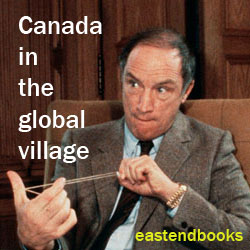David Emerson and Democracy in Canada : new perils in new age of minority government?
Feb 11th, 2006 | By Counterweights Editors | Category: Ottawa Scene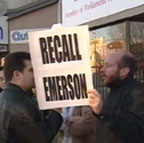 The counterweights editors count themselves among those who do not vigorously oppose former Liberal cabinet minister David Emerson’s decision to cross the floor and join Stephen Harper’s new Conservative cabinet. But by the end of the new Harper government’s first week in office it seems clear enough that many others do.
The counterweights editors count themselves among those who do not vigorously oppose former Liberal cabinet minister David Emerson’s decision to cross the floor and join Stephen Harper’s new Conservative cabinet. But by the end of the new Harper government’s first week in office it seems clear enough that many others do.
The diverse critics include Will McMartin on the BC website The Tyee, BC NDP MP Peter Julian, Alberta Conservative MP Myron Thompson, Ontario Conservative MP Garth Turner, Ottawa journalism dean Jeffrey Simpson, Ottawa democracy watchdog Duff Conacher, and many other Canadian citizens who have signed a petition on the instant website recalldavidemerson.com.
As Will McMartin’s piece in The Tyee nicely explains, the crux of the issue is whether we the voters are voting for the person or the party when we elect the MPs for our ridings. And the old tradition is that we vote for the person. Down to as recently as 1972, party labels were not even included on our ballots, as some of us are already too old enough to remember.
We can still see arguments for continuing this tradition, especially in the kind of fractured minority-government Parliaments that the people of Canada in their wisdom have now voted for in the two successive elections of 2004 and 2006. And David Emerson’s decision to join the new Conservative cabinet has also had its supporters as well as its critics over the past week – including the premier of British Columbia and most Conservative MPs in Ottawa.
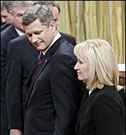 At the same time, recent political science research does show that nowadays most voters tend to make their choices on the basis of the party label first, the party leader second, and the person representing the party in their local riding third. And this no doubt does qualify as a pretty good argument for some such new convention as requiring MPs who switch parties between elections to run under their new party label in a by-election (a proposal that already figures in current federal NDP accountability proposals).
At the same time, recent political science research does show that nowadays most voters tend to make their choices on the basis of the party label first, the party leader second, and the person representing the party in their local riding third. And this no doubt does qualify as a pretty good argument for some such new convention as requiring MPs who switch parties between elections to run under their new party label in a by-election (a proposal that already figures in current federal NDP accountability proposals).
If this is going to be the new convention of Canadian parliamentary democracy, however, it ought to be somehow democratically decided and made clear. Jeffrey Simpson of the Globe and Mail, e.g., has also just been arguing that the country needs a new federal commission of inquiry on Canada’s economic prospects. It could probably stand some kind of new federal citizens’ assembly on democracy in Canada today as well – to get at issues like switching political parties between elections (and even such related democratic subjects as reforming the Senate and the office of the governor general too).
From Thursday, February 9 counterweights: RIGHT-WING SPIN IN CANADA .. just how secure are the Conservatives anyway?
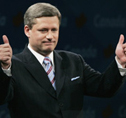 Two days after the swearing-in of Stephen Harper’s new Conservative Government of Canada, Global Public Affairs and the Canada West Foundation hosted a breakfast seminar on what the new order means for “the Canadian federation” at the Ontario Club in Toronto. (A parallel seminar had already been held in Calgary, on the day the new government was sworn in.)
Two days after the swearing-in of Stephen Harper’s new Conservative Government of Canada, Global Public Affairs and the Canada West Foundation hosted a breakfast seminar on what the new order means for “the Canadian federation” at the Ontario Club in Toronto. (A parallel seminar had already been held in Calgary, on the day the new government was sworn in.)
The subtext of three very able presentations by public policy professionals not unsympathetic to the new order was that, as Roger Gibbins of the Canada West Foundation summed things up, even though the Harper minority government has fewer seats in the federal Parliament than the Martin minority government it is replacing, it is actually in a considerably more secure position.
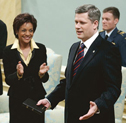 None of the three opposition parties, on this view, has any interest in forcing yet another federal election any time soon. Only the Conservatives themselves would welcome such a prospect (in a bid for the kind of overwhelming majority government the Diefenbaker Conservatives won on March 31, 1958, less than 10 months after they first won a very slender minority government on June 10, 1957). And this will likely enough keep Stephen Harper comfortably in the driver’s seat of what amounts to a slender minority government that is effectively a majority government – even until after the US Presidential election of 2008.
None of the three opposition parties, on this view, has any interest in forcing yet another federal election any time soon. Only the Conservatives themselves would welcome such a prospect (in a bid for the kind of overwhelming majority government the Diefenbaker Conservatives won on March 31, 1958, less than 10 months after they first won a very slender minority government on June 10, 1957). And this will likely enough keep Stephen Harper comfortably in the driver’s seat of what amounts to a slender minority government that is effectively a majority government – even until after the US Presidential election of 2008.
This audacious scenario is not unlike the one that the new prime minister from Alberta has apparently hit the ground running with himself. And who knows? Time may even prove that it is correct enough. But it also dramatically writes off the potential for a considerably more interesting and constructive new era in Canadian federal politics, that lies latent in the still highly fractured 39th Parliament elected on January 23. It similarly blithely ignores the plain democratic fact that only 36.3 % of the interested Canadian people have actually voted for the Harper Conservatives. In the now 139-year-old history of the Canadian federation the only government that has held office with a slightly lower percentage of the popular vote was Joe Clark’s short-lived Conservative minority regime of 19791980.
Just how rotten is the current state of the Liberal Party?
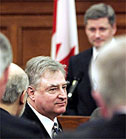 Stephen Harper’s biggest ace in the hole at the moment, as seen by proponents of the effective Conservative majority theory of the new era in Canadian politics, is the current disarray of the Liberals.
Stephen Harper’s biggest ace in the hole at the moment, as seen by proponents of the effective Conservative majority theory of the new era in Canadian politics, is the current disarray of the Liberals.
For one thing, Paul Martin has not in fact exactly resigned as Liberal leader, despite what he seemed to many to be saying on the evening of January 23. Bill Graham is just going to be interim leader of the Liberals in opposition. Martin officially remains Liberal leader. Until he finally resigns properly, some party insiders say, there cannot really be a proper Liberal leadership race. (Thus the real reluctance of Mssrs. Manley, McKenna, Tobin, etc.) And if Martin himself tried to lead the party in another election, the still warring Chretienites and Martinites would just tear each other apart.
There appears to be one possible exception to this scenario of absolutely no more elections for Paul Martin, apparently already known among Liberal party insiders as the Trudeau theory (and widely regarded as too much of a joke to work, for the moment at least?).
Suppose, e.g., that, as early as this coming spring, the audacious new Conservatives go ahead with the “parliamentary strategy” that John Ibbitson of the Globe and Mail has just reported on. They “scrap the Liberal child-care program and replace it with direct cheques.” As Ibbitson also explains: “All other parties oppose this program. By fast-tracking it, Mr. Harper is forcing them to either let it pass or to bring down the government immediately.”
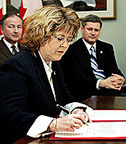 On the new effective Conservative majority theory, none of the opposition parties will have the guts (or stupidity?) to “bring down the government immediately,” and force a fresh election only months after the last one. The Liberals (and the Bloc Quebecois and the New Democrats) will just have to lump it and like it. And once this pattern of opposition weakness sets in, it could go on for quite a while. (Roger Gibbins, e.g., does seem to be imagining at least as long as until after the 2008 US Presidential election, which will finally get rid off the George W. Bush who is so widely disliked in all parts of Canada today.)
On the new effective Conservative majority theory, none of the opposition parties will have the guts (or stupidity?) to “bring down the government immediately,” and force a fresh election only months after the last one. The Liberals (and the Bloc Quebecois and the New Democrats) will just have to lump it and like it. And once this pattern of opposition weakness sets in, it could go on for quite a while. (Roger Gibbins, e.g., does seem to be imagining at least as long as until after the 2008 US Presidential election, which will finally get rid off the George W. Bush who is so widely disliked in all parts of Canada today.)
On the Trudeau theory, on the other hand, the whole situation is more reminiscent of February 18, 1980 – when Pierre Trudeau unexpectedly came back from the dead, after the Joe Clark Conservative minority government elected on May 22, 1979 was defeated in the House, thanks in part to the parliamentary skills of Allan MacEachen (who was playing for Trudeau about the same role that Bill Graham is now playing for Paul Martin).
In this case more feisty and gutsy opposition parties would combine to defeat an increasingly arrogant new Prime Minister Harper in the House on the child-care issue. (And note that Mr. Harper already seems to be in a bit of trouble on this issue with some provincial premiers.) Paul Martin would have to lead the Liberals in an election again, because no one else would yet be available. And who knows? He might even return as at least the leader of another Liberal minority government, perhaps somewhat more numerously supported by New Democrats.
As already alluded to, even Liberal party insiders do not appear to see this kind of Trudeau-theory scenario as very plausible at the moment. The Liberals, it would seem, are suddenly just in too much disarray to bring such a clever stunt off – and they increasingly even seem to lack the required financial resources. But perceptions of this sort can change quickly enough under stress. And if Prime Minister Harper does push his own “govern-as-if-you-had-a-majority” parliamentary strategy as hard as now seems possible, he will be putting all the opposition parties – and even perhaps the Canadian federation at large – under quite a lot of stress.
Another theory … a new era of parliamentary democracy?
 There would seem to be another way of looking at the child-care issue that John Ibbitson puts at the centre of what might happen once Parliament returns on April 3 – and a related other way of characterizing the stress that the new effective Conservative majority theory potentially puts on the democratic status of the Canadian federation.
There would seem to be another way of looking at the child-care issue that John Ibbitson puts at the centre of what might happen once Parliament returns on April 3 – and a related other way of characterizing the stress that the new effective Conservative majority theory potentially puts on the democratic status of the Canadian federation.
In the first place here, it does seem not altogether clear that, e.g., the combined opposition parties would actually have to defeat the new government, in order to constrain its options on child-care policy – or almost any other issue. The traditional and highly flexible “Westminster” parliamentary system of democratic government has resources in minority government situations that Canadian experience has yet to explore in any detail. And it is arguable that, after two consecutive elections in which the minority governing party has received an unusually low percentage of the popular vote, this is what the Canadian people in their collective democratic wisdom actually want their politicians to start exploring.
 Paul Martin discovered that winning 36.7 % of the popular vote in 2004 was finally not good enough to run a minority government as if it were a majority government. And now that Stephen Harper has won only 36.3 % he may well finally discover the same thing – one way or another.
Paul Martin discovered that winning 36.7 % of the popular vote in 2004 was finally not good enough to run a minority government as if it were a majority government. And now that Stephen Harper has won only 36.3 % he may well finally discover the same thing – one way or another.
When this point is put to some proponents of the new effective Conservative majority theory, they say that governing aggressively with such low levels of cross-Canada democratic support is just part of the traditional rules of the game in Canadian federal politics. And that is in some degree true.
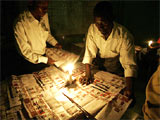 But even a quick look at the history of the 39 elections that have been held since the start of the modern Canadian federation in 1867 also suggests that the ultimate democratic character of these traditional (and almost entirely “unwritten”) rules themselves has increasingly been brought into question over the more recent past. Democracy, that is to say, is not just about the rule of the majority. But that certainly is one key part of what it means. And if you have no rule of the majority at all, you no longer have democracy.
But even a quick look at the history of the 39 elections that have been held since the start of the modern Canadian federation in 1867 also suggests that the ultimate democratic character of these traditional (and almost entirely “unwritten”) rules themselves has increasingly been brought into question over the more recent past. Democracy, that is to say, is not just about the rule of the majority. But that certainly is one key part of what it means. And if you have no rule of the majority at all, you no longer have democracy.
In 11 of the first 13 Canadian federal elections, e.g., the governing party won at least 50% or more of the popular vote. In the next 13 elections the governing party won at least 50% or more of the popular vote only four times, and in the 13 most recent elections this happened only once. In the two most recent elections of 2004 and 2006 the governing party has won a smaller percentage of the popular vote than in any other two consecutive elections in all of Canadian political history.
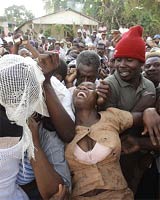 Many more active and concerned ordinary Canadian voters are aware of these kinds of numbers. They have a lot to do with current enthusiasms for some form of “proportional representation” reform of the Canadian electoral system – and with broader current concerns about “democratic renewal” in Canadian government and politics. The underlying problem here is the growth of various kinds of “third parties” in the old traditional two-party Canadian political system. (And you can link the departures from at least 50% or more of the popular vote in the table below with the history of third-party development in Canada rather tidily.)
Many more active and concerned ordinary Canadian voters are aware of these kinds of numbers. They have a lot to do with current enthusiasms for some form of “proportional representation” reform of the Canadian electoral system – and with broader current concerns about “democratic renewal” in Canadian government and politics. The underlying problem here is the growth of various kinds of “third parties” in the old traditional two-party Canadian political system. (And you can link the departures from at least 50% or more of the popular vote in the table below with the history of third-party development in Canada rather tidily.)
Whatever else you may or may not want to say about it, the new effective Conservative majority theory of the 2006 Canadian federal election that is still only a few weeks old is profoundly undemocratic. Hard-nosed backroom political strategists can and often do dismiss objections of this sort as just so much practically meaningless pie in the sky. But the present-day drive to make Canadian politics more and not less democratic has been an important part of the popular (and even “Western Canadian populist”) energy behind the growth of Stephen Harper’s new Conservative Party of Canada. And it still seems not too bad a guess that just how long any party which so quickly turns its back on its nourishing popular currents can finally last in office remains a very open question. That does not really seem to be what John Diefenbaker did in 1957 and 1958 at all. (And look what happened in the very end to Dief the Chief in any case.)
Governing Party Popular Vote in Canadian Federal elections, 1867-2006
|
Election |
Seat Result |
% Popular Vote |
|
NEW AGE OF MINORITY GOVERNMENTS? |
||
|
2006 January 23 |
Cons minority |
36.3 |
|
2004 June 28 |
Lib minority |
36.7 |
|
JEAN CHRETIEN LIBERALS |
||
|
2000 November 27 |
Lib majority |
40.8 |
|
1997 June 2 |
Lib majority |
38.5 |
|
1993 October 25 |
Lib majority |
41.3 |
|
BRIAN MULRONEY CONSERVATIVES |
||
|
1988 November 21 |
Cons majority |
43.0 |
|
1984 September 4 |
Cons majority |
50.0 |
|
AGE OF PIERRE TRUDEAU (AND JOE CLARK INTER-REGNUM) |
||
|
1980 February 18 |
Lib majority |
44.3 |
|
1979 May 22 |
Cons minority (Lib 40.11) |
35.9 |
|
1974 July 8 |
Lib majority |
43.2 |
|
1972 October 30 |
Lib minority |
38.5 |
|
1968 June 25 |
Lib majority |
45.5 |
|
DUEL IN THE SUN: DIEF THE CHIEF VS. MIKE PEARSON |
||
|
1965 November 8 |
Lib minority (very strong) |
39.8 |
|
1963 April 8 |
Lib minority |
41.7 |
|
1962 June 18 |
Cons minority |
37.3 |
|
1958 March 31 |
Cons majority |
53.7 |
|
1957 June 10 |
Cons minority (Lib 42.3) |
39.0 |
|
MACKENZIE KING TRIUMPHANT (AND UNCLE LOUIS) |
||
|
1953 August 10 |
Lib majority |
50.0 |
|
1949 June 27 |
Lib majority |
50.1 |
|
1945 June 11 |
Lib majority |
41.4 |
|
1940 March 26 |
Lib majority |
54.9 |
|
1935 October 14 |
Lib majority |
44.4 |
|
MACKENZIE KING VS. MEIGHEN AND BENNETT |
||
|
1930 July 28 |
Cons majority |
49.0 |
|
1926 September 14 |
Lib minority 116 (Cons 46.2) |
43.6 |
|
1925 October 29 |
Cons minority 116 |
46.6 |
|
1921 December 6 |
Lib minority 116 |
40.7 |
|
BORDEN TORIES (AND EARLY QUEBEC NATIONALISM?) |
||
|
1917 December 17 |
Cons majority (Unionist?) |
57.0 |
|
1911 September 21 |
Cons majority |
51.2 |
|
WILFRID LAURIER GRITS/LES ROUGES |
||
|
1908 October 26 |
Lib majority |
50.6 |
|
1904 November 3 |
Lib majority |
52.5 |
|
1900 November 7 |
Lib majority |
52.0 |
|
1896 June 23 |
Lib majority (Cons 46.3) |
45.1 |
|
JOHN A. MACDONALD TORIES/LES BLEUS |
||
|
1891 March 5 |
Cons majority |
52.0 |
|
1887 February 22 |
Cons majority |
50.7 |
|
1882 June 20 |
Cons majority |
53.4 |
|
1878 September 17 |
Cons majority |
53.2 |
|
FOUNDING DECADE |
||
|
1874 January 22 |
Lib majority |
53.8 |
|
1872 July 20October 12 |
Cons majority (just?) |
49.9 |
|
1867 August 7September 20 |
Cons majority (coalition?) |
50.0 |
SOURCE: Library of Parliament, as reported on the Nodice website.
